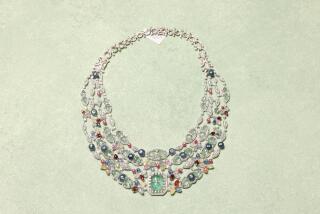When a Stone Was Sold It Was Crandall’s Gain, Investor’s Loss
- Share via
While sentencing the principals of Crandall Financial Corp., U.S. District Judge Edward Rafeedie characterized them as a pack of cold-hearted criminals who operated with complete disregard for their clients.
“There was an utter callousness by these people with regard to these victims,” Rafeedie said in U.S. District Court in Los Angeles. “That is an inherent way of larceny. Once the proceeds of larceny begin rolling in, the people that are involved in it tend to go after more and more and more, and that is what I believe happened to these people.”
Investors were told that if they refinanced their homes and invested the money with Crandall, the company would make their mortgage payments from the profits on their investments. At least one client found out that those payments were not made when he was notified that a home he owned was in foreclosure.
“I knew Crandall closed when I got a statement that they (his mortgage company) were foreclosing on the home,” said Fred Dorn, a retired San Diego fireman and double amputee who lost an estimated $225,000. “That’s the first time I knew of the Crandall demise.”
Crandall salesmen told investors that salesmen received an 8% commission when an investor bought a stone and an additional 5% commission when the stone was sold, leading investors to believe that the full commission was 13%, said Sharon McCaslin, a deputy attorney general and a prosecutor in the case.
“What they weren’t told is that brokers were paid 25% to 42.5% commission,” McCaslin said. “Plus another 15% of all sales went to the (sales) group manager. When you’re an investor, it’s one thing to pay 8%, but the fact was that someone was making 50% off of you.”
Crandall salesmen told prospective clients that investors were averaging a 35% annual profit on their gems. “But every time a customer came in and tried to resell their gems through Crandall (during a 15-month investigation), they did so at a loss,” McCaslin said. “We traced the gems. Crandall puts the gem back into the inventory. But then there’s always a Crandall gain on a resell.”
Dorothy Wright, a 75-year-old Woodland Hills woman, for example, purchased a colorless, nearly flawless half-carat diamond for $5,185 in September, 1983. When she sold it back to Crandall exactly a year later, according to court records, she received only $2,592.50 for the gem, a loss of 50%. But less than a month after that, Crandall sold the same diamond to another unwitting investor for $5,214.93.
In addition, according to the indictment, gems sold to investors were marked up over Crandall’s original cost from approximately 149% to more than 300%. And salesmen did not receive a commission on money their clients invested in Crandall moneymarket plans. They did, however, receive commissions when they used investors’ moneymarket funds to buy gems.
Fred Dorn originally invested in a Crandall moneymarket account, he said, “but I kept getting receipts or confirmation that they were buying diamonds. I didn’t authorize that. And then I come to find out they were paying exorbitant amounts for those (gems) just to get commission.”
More to Read
Inside the business of entertainment
The Wide Shot brings you news, analysis and insights on everything from streaming wars to production — and what it all means for the future.
You may occasionally receive promotional content from the Los Angeles Times.











